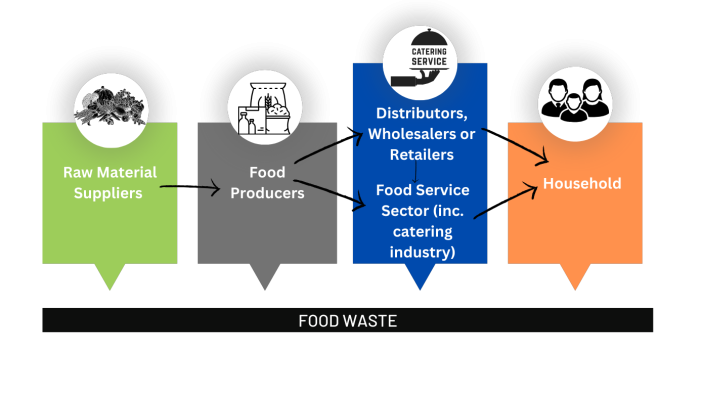Food waste is a global challenge with significant environmental, economic, and ethical implications. It refers to the portion of food originally produced for human consumption that is discarded somewhere in the food supply chain, excluding animal feed and inedible parts of products (see Figure 1). In the catering industry, food waste occurs both in the kitchen during food preparation and in the hands of customers, where leftovers often find their way to the bin due to factors like bad flavors, aversions, and oversized portions (Wu, Mohammed, & Harris, 2021).
Figure 1: Food waste and different stages of the food supply chain

In this blog, I delve into the importance of sustainable food waste management, exploring causes and effects and providing some strategies based on the findings from the paper by Wu et al. (2021) in Industrial Marketing Management.
Why Sustainable Food Waste Management?
- Reducing greenhouse gas emissions. The decomposition of food waste in landfills produces methane, a potent greenhouse gas.
- Cost savings and economic gains. According to Martin-Rios, Hofmann, and Mackenzie (2021), the food service industry faces an annual average global cost of EUR 2.4 trillion due to food waste.
- Positive corporate image and marketing strategy. Wu et al. (2021) highlight that a sustainable agenda, including effective waste management, not only contributes to a positive corporate image but also enhances overall marketing strategies.
Designing Effective Food Waste Prevention and Reduction Strategies
Understanding the causes of food waste is essential for designing effective prevention and reduction strategies. As highlighted in Table 1, based on the research Wu et al. (2021) in Industrial Marketing Management, addressing the root causes of food waste is more impactful than dealing solely with its effects.
Table 1: Food waste causes and strategies

Addressing the most crucial factors of food waste is key to mitigating waste issues with limited resources and maximizing value for the business. Utilizing the chart above daily enables proactive food waste prevention by effectively managing and controlling the major causes (Wu et al., 2021).
In the upcoming blogs, I will provide actionable tools for businesses in the catering industry to implement sustainable practices. Stay tuned!
References
Wu, Z., Mohammed, A., & Harris, I. (2021). Food waste management in the catering industry: Enablers and interrelationships. Industrial Marketing Management. Retrieved from www.elsevier.com/locate/indmarman
Martin-Rios, C., Hofmann, A., & Mackenzie, N. (2021). Sustainability Oriented Innovations in Food Waste Management Technology. Sustainability, 13, 210. https://doi.org/10.3390/su13010210



